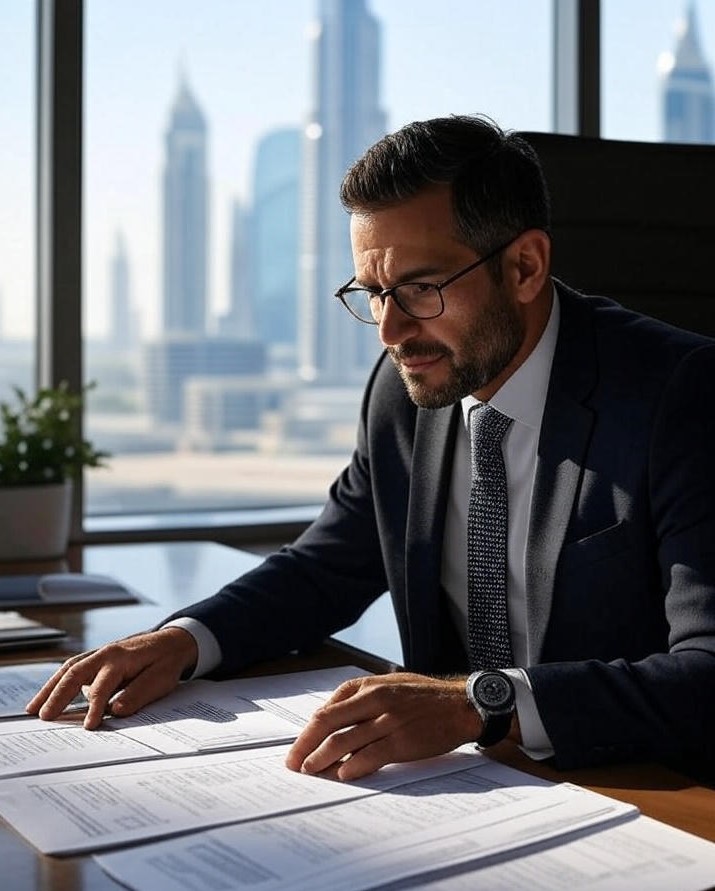Dubai Property Investment in Dubai’s skyline showcases rapid development, prompting questions in 2025 about whether the market is oversaturated. Experts argue that real estate is not uniformly flooded. With a projected population of 3.65 million in 2024 and 17 million tourists in 2023, overall demand remains strong. Projects are rolled out in stages to target diverse buyers. In prime areas like Downtown and Dubai Creek Harbour, resale inventory is limited, leading to rising prices. Meanwhile, there is a higher supply in areas like Jumeirah Village Circle, but this is not widespread. Ultimately, “oversupply” depends on product and location, and savvy investors are focusing on well-researched communities where demand outpaces supply.

Off-Plan vs. Ready-to-Occupy Properties: Advantages and Disadvantages
Investors often ask, “Should I buy an off-plan property or a ready property in Dubai?” Each option has its pros and cons.
👀Ready-to-buy:
Homes tend to cost more upfront but provide immediate rental income. They offer certainty, as you can see the finished unit and know the rental yield (typically 4–6% in luxury areas) right from the start.
✅Off-Plan:
On the other hand, “off-plan” units can be purchased at lower prices with flexible payment plans, but they require patience. During the construction phase, off-plan properties often appreciate (on average 10–15% per year before handover), which can lead to higher capital gains if the location becomes popular. However, off-plan investors typically have to wait 2–4 years for completion and face potential market risks or delays. In oversupplied districts, this waiting period can carry additional risks.
Point comparison
✅Ready Property:
These properties generate immediate rental income and offer stable returns on investment (ROI), typically around 4.9% in Downtown and 5.3% in Palm Jumeirah. However, they come with a higher initial price and limited payment flexibility.
✅Off-Plan Property:
These properties require a lower down payment and offer flexible payment plans, with the potential for 10-15% annual capital appreciation before handover. However, they involve delayed returns and higher uncertainty due to market fluctuations and developer reliability.
A balanced investment strategy often proves to be the most effective. By securing a mix of “ready homes for cash flow” and “selective off-plan deals for long-term gains”, especially in master-planned communities like Dubai South and Damac Hills 2, you can position yourself for growth. Always conduct thorough due diligence on developers and avoid paying speculative premiums. One investor advises, “Buy at the right value by comparing your entry price to similar projects.”

Where to Invest for Maximum Returns?
Dubai continues to outperform many global cities when it comes to property investment. While many world-class markets yield only 2–4%, Dubai’s gross rental yields typically range from 5–9%. For instance, in mid-2025, a studio in Downtown Dubai was yielding approximately “8.4%”, while a studio in Palm Jumeirah was yielding about “8.7%”. Notable high-yield areas include “Al Furjan” (with yields of up to approximately 8.8%), “Jumeirah Lake Towers”, “Jumeirah Village Circle”, and more affordable districts like “Dubai South”.
✅- Luxury and Downtown Zones:
Areas such as Dubai Marina, Downtown, and the Dubai International Financial Centre (DIFC) show strong demand and decent yields, often between “6–8%” for apartments.
✅- Emerging Communities:
Neighborhoods like Dubai South, Arjan, Dubai Land, and Damac Hills have lower entry prices and potential for good yields, although they may face oversupply challenges.
✅- Off-Plan Opportunities:
Projects like Emaar’s Oasis in Dubai South and Sobha developments in District 11 are marketed with expected returns on investment (ROIs) between 7–9%.
Long-term capital growth is also favored in master-planned, amenity-rich developments. For example, areas like Downtown and Business Bay have experienced price growth of around “18–25% year-over-year”, supported by new infrastructure initiatives such as the Expo 2020 legacy in Dubai South, which underpins future property appreciation.
Unlocking Golden Opportunities: Invest in Property for Your Golden Visa!
A common question people often ask is: “How much do I need to invest in property to qualify for a UAE Golden Visa?” The requirements are straightforward: to obtain a “10-year Golden Visa”, you must make a minimum investment of “AED 2 million” in real estate. This investment can be achieved through one or more properties with a combined value of AED 2 million or more, even if they are mortgaged (as long as there is a bank No Objection Certificate). This investment allows both the investor and their family to secure long-term residency.
Dubai has also introduced “lower-tier investor visas” connected to real estate. A “5-year residency” visa requires an investment of AED 1 million in property, while a “2-year residency” visa necessitates an investment of AED 750,000 (mortgages are accepted under certain conditions). Although these options are not officially referred to as “Golden Visas,” they still enable foreign buyers to reside in the UAE through property purchases.
Why does it matter?
Golden Visas significantly boost demand, as purchasing a property valued at AED 2 million or more grants a 10-year visa that includes family sponsorship. The 5- and 2-year residency options also make mid-range investments more appealing by providing legal stability and easier access to residency. Many investors consider visa eligibility when planning their budgets and often choose projects that qualify for these visa programs.
☢️Transforming Property Laws: The Impact of Regulatory Reforms
In 2025, Dubai implemented significant legal reforms to strengthen investor confidence. “Law No. 6 of 2025” grants the Dubai Municipality greater control over government land allocation, ensuring strategic and sustainable development. This measure, aligned with the Dubai 2040 Urban Plan, is perceived as a positive signal to global investors, promising increased transparency and stability. Experts comment that the new law “reflects strategic thinking” and “reinforces Dubai’s position as a leader in sustainable growth.”
Alongside the land law, Dubai’s authorities have improved transparency by making real estate transaction data—such as sales, mortgages, and valuations—publicly accessible. Additionally, the partnership between the Dubai Land Department (DLD) and developers streamlines the registration process. Together, these reforms optimize land use and facilitate due diligence for investors.
Dubai is also liberalizing property ownership rights for foreign investors. Freehold ownership (full title deed) for non-citizens continues to be allowed in designated areas, and the “expansion of freehold zones” has been a recent trend. For instance, in January 2025, Dubai opened the Al Jaddaf district to freehold ownership, while Sheikh Zayed Road has also transitioned to freehold status. This expansion offers “more choice and flexibility” for investors, reflecting Dubai’s long-term vision for a globally accessible market.
✅Freehold vs. Leasehold:
Understanding the difference is crucial. In Dubai, a “freehold” property means the owner holds the title deed for both the building and the land underneath it. In contrast, a “leasehold” property grants ownership rights for a fixed term (typically up to 99 years) and often comes with restrictions on renovation, inheritance, etc. Freehold ownership is generally more attractive as it is tradable, inheritable, and tends to appreciate steadily. Leasehold values, however, often decline as the lease expiration approaches. Historically, freehold ownership was limited to special zones, but with more areas converting—like Al Jaddaf—international buyers now have greater opportunities.
✅Key Takeaways for Investors
Dubai’s property market in 2025 presents an “opportunity with caution”. The macro trends are positive, showcasing robust population growth, record-breaking sales in 2023–2024, and investor-friendly policies such as Golden Visas and new regulations. With rental yields remaining among the highest globally and prime areas continuing to appreciate, there’s much potential. However, smart investing requires careful selection of locations and property types. Here are key takeaways for investors:
Research Demand vs. Supply:
Avoid chasing overheated submarkets. Instead, focus on areas with proven end-user demand, such as Downtown, Business Bay, Marina, Creek Harbour, and Dubai South.
Balance Income and Growth:
Consider a combination of ready assets for immediate rental income and selected off-plan properties that offer lower entry prices and potential for future gains.
Leverage Visa Opportunities:
If obtaining a Golden Visa is a goal, aim for purchases of AED 2 million or more. For those with smaller budgets, the 2- and 5-year investor visas can provide residency benefits.
👉🏻Stay Informed on Regulations:
Take advantage of expanding freehold zones and be aware of local regulations, such as Dubai’s tenancy and property laws, especially when purchasing in leasehold areas.
In summary, Dubai continues to reward well-informed investors. By addressing oversupply concerns through careful market analysis, selecting the best property types, and leveraging policy incentives, investors can achieve “solid returns and long-term growth” in Dubai’s evolving real estate landscape and for this Helmand Properties expert and professional team is here to guide you and provide you best free consultation and services.